Dinosaurs and other prehistoric animals of Brazil
Beneath its surface, Brazil has a vast and fascinating prehistory, preserved in fragments of millions of years. Through thick layers of sediments, we can discover which animals lived here, how they lived, for how long, how they died, what the climate was like, or even why certain animals did not live in Brazil. All this is stored under our feet.
Paleozoic Era
During the Paleozoic era, before the dinosaurs existed, the Earth was very different from what we know today. There were no continents as we know them today, they were all combined into one huge misshapen continent. While some of our future continents were still submerged, others that we may never know existed1,2.
It was after the Cambrian explosion, 570 million years ago, that the first marine shell animals such as trilobites, mollusks and echinoderms appeared, and fossils could finally, be preserved.
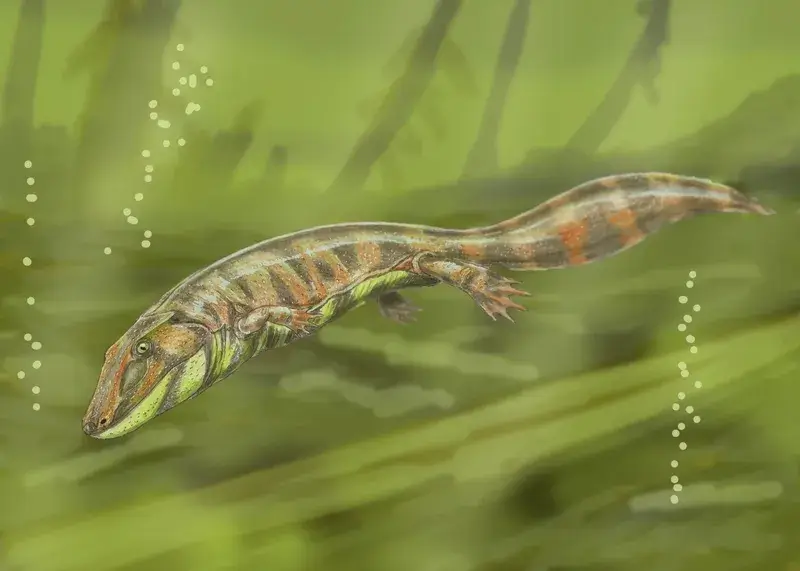
A few thousand years later, plants and terrestrial arthropods such as insects, spiders, and centipedes appeared. Thousands of years later, in the Devonian period (about 420 million years ago), fish appeared and from them the first land animals - the amphibians3. Only in the following period, in the Carboniferous, the first reptiles appeared.
The Paleozoic Era lasted about 291 million years, and during this time most of the territory that would later become Brazil was at various times dry, flooded, frozen, or several of these simultaneously, depending on the region.
So Brazil was a relatively inhospitable place for thousands of years, and little is recorded in our rocks. Nevertheless, we can find fossils of trilobites, mollusks, other marine invertebrates and some fishes in the Amazon, Parnaíba and Paraná sedimentary basins4.
The period after the Carboniferous is called the Permian - it is the last of the Paleozoic. The climate in the Brazilian lands became a little more habitable and was able to support reptilian archosaurs5 (which would give rise to dinosaurs and pterosaurs)6, synapsids7 8 9 (from which the ancestors of mammals would originate), large amphibians, and various other tetrapods (animals with four limbs).
Fossils of various animals from the Paleozoic era have been preserved in the Paraná, Parnaíba, and Amazon basins and in Rio Grande do Sul. Some examples are the parareptiles Stereosternum tumidum4, several species of large sharks known as ctenacantiformes,10 amphibians over two meters long such as temnospondyls11 and the dicinodonts (a type of synapsid, which we mentioned earlier).
The Permian extinction was the biggest of all, wiping out about 80% of the animals3 and ending the Paleozoic era. Some of those that survived were the ones that gave rise to the dinosaurs in the next era, the Mesozoic, and all the other animals we know today.
Mesozoic Era
Triassic

The Mesozoic Era is divided into three periods, the Triassic, the Jurassic and the Cretaceous . In the early Triassic , large herbivorous archosaurs, called aetosaurs, and carnivorous archosaurs like the rauissuquids, reigned supreme.Although little known, rauissuquids could reach up to 6 m (20 ft) in length and certainly had protodinosaurs (primitive dinosaurs) as part of their diet.
Besides the archosaurs, other very important tetrapods were the cynodonts and dicynodonts. Among the dicinodonts we can mention the Dinodontosaurus turpoi,4 an animal about 6 feet tall with large downward pointing tusks, like those seen in saber-toothed tigers. In these animals, however, the large fangs were probably used to pluck tubers and roots from the ground or in fights.
Cynodonts, on the other hand, were animals that varied greatly in shape and size, ranging from the size of a mouse to over 5 feet long. These animals had long bodies, short legs, hair, and could be carnivorous, herbivorous, or omnivorous. Eram deles que evoluiriam os ancestrais dos mamíferos. Curiously, cynodonts laid eggs, but they already had glands capable of secreting nutrient-rich fluid for their offspring; more than 20 species of cynodonts have been discovered in Brazil12.
The dinosaurs of the Triassic were relatively smaller than those of the Jurassic and Cretaceous. Even the largest sauropods of the time were about 1.5 m (5 ft) tall and 3.5 m (10 ft) long. They were not yet true dinosaurs, but they were the basis of the various evolutionary lineages that emerged in subsequent periods.
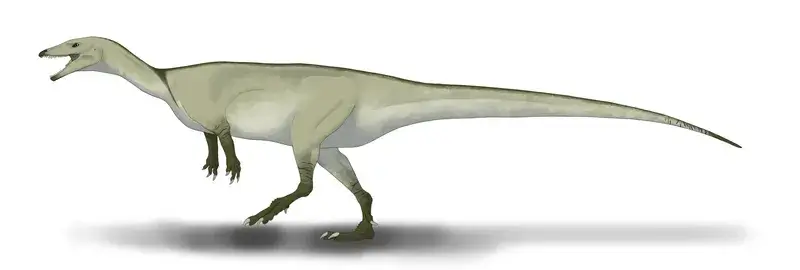
Among the protodinosaurs of that time that we can find in Brazil are fossils of dinosauromorphs,13 sauropodomorphs14 such as Pampadromaeus barberanai and Buriolestes schultzi, and fossil footprints of ornithischians such as Sacisaurus agudoensis15 and Gamatavus antiquus.
There were also the predecessors of the pterosaurs, the pterosauromorphs,16 such as Ixalerpeton polesinensis. During the Triassic, pterosauromorphs were more like small theropods, were bipedal, and did not yet have wings.
Most, if not all, of Brazil’s Triassic animal fossils have been found in Rio Grande do Sul. During this time, all the continents were united in a single megacontinent called Pangea. Brazil was united with Africa and there was no coastline, the nearest coast was more than 2 thousand kilometers away, making most of the continent arid.
In the region of Rio Grande do Sul, however, there were several rivers that flooded every year, making the local vegetation lush and attracting many animals.4 Thus, it became the most favorable place to preserve fossils from this period.
At the end of the Triassic, another extinction ended the line of hundreds of animals. The dinosaurs, still small but with a wide variety of diets and appearances, were able to survive and adapt. With the demise of many larger animals, competition for food decreased and the dinosaurs had more room to evolve, thrive, and finally begin their reign.
Jurassic
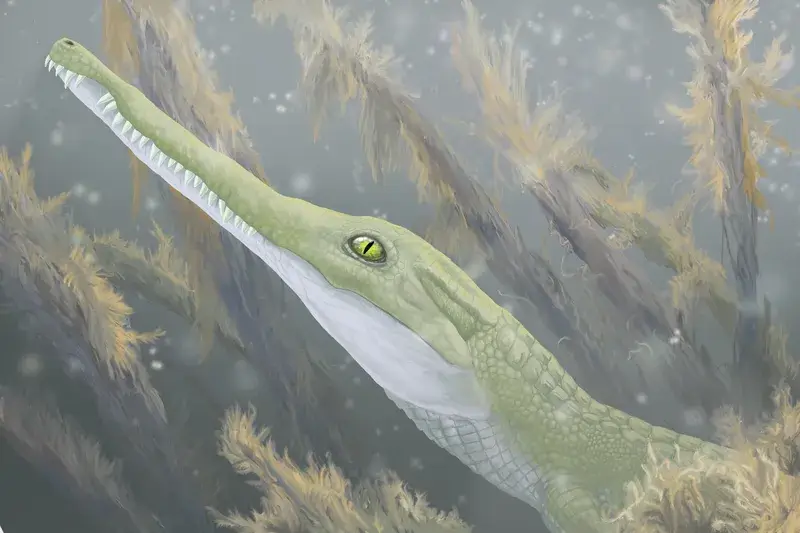
During the Jurassic period, there were already flying basal pterosaurs, plesiosaurs, ichthyosaurs and, of course, dinosaurs. There were giant sauropods, stegosaurs, compsognathus and the famous Archeopteryx, but there are no fossils of these animals in Brazil.
We can find fossils from the Jurassic period in Brazil of some fishes17 and a small crocodilomorph (Batrachomimus pastosboensis) in the Parnaíba Basin, and only4.
No dinosaur fossils have ever been found in Brazil during the Jurassic period, not because they didn’t live here, but because the geology of the time was not favorable for fossilization. The Brazilian land was covered by vast deserts of dunes and rocks, and the lack of water meant that few animals could live here.
How are fossils preserved?
To become fossilized, an animal’s body must be quickly covered with mud, sand, or other material that protects it. If exposed to the elements, it will be crushed or eaten by other animals, carried away by floods, and destroyed by exposure. The longer it is exposed, the less chance it has of being preserved.
Continents are in constant motion and can directly affect the preservation of fossils. During the Jurassic period, continental drift was no exception. However, instead of just moving laterally, the continent was lifted up by the Earth’s mantle.
Instead of the movement creating depressions where sediments could accumulate and fossils could be preserved, it was rising and exposed to erosion. As a result, there were few shallow regions where dinosaur or other animal bones could accumulate and be preserved.4.
Cretaceous
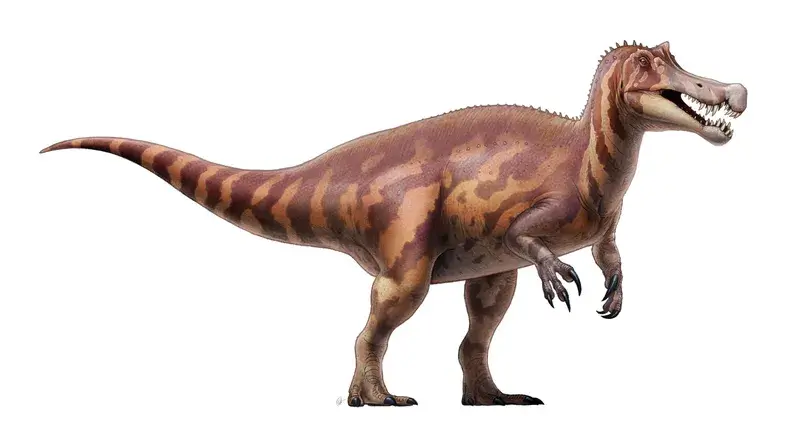
The Cretaceous is undoubtedly the most famous geological period in history, during which many magnificent dinosaurs appeared, disappeared or survived. It is in the Cretaceous that the Tyrannosaurus, Spinosaurus, the giant Argentinosaurus, Velociraptor, different reptiles such as Mosasaurus, Pterosaurus and many other animals lived.
In Brazil it was no different, the Cretaceous is the period with the largest number of dinosaurs known in the country. It was during the Cretaceous that South America began to separate from Africa, first opening a river between the two continents that later became the Atlantic Ocean.
Although much of the country is still a vast desert, the separation also opened several paths for rivers and lakes to flow into the interior of Brazil, allowing water to irrigate some parts of this vast and arid country, favoring the growth of vegetation as in no other era and making the environments near these bodies of water habitable for many animals4.
The São Luís-Grajaú and Parnaíba basins, in Maranhão, were some of the places where many animals lived and their fossils were preserved. Dozens of fossils of fishes, amphibians, arthropods, a legged snake (Tetrapodophis amplectus)18, more than 30 species of pterosaurs16 (one of the largest deposits of pterosaurs in Brazil), birds,19 20 mosasaurs, plesiosaurs and turtles have been found.
Fossils of several theropod dinosaurs have also been found there: such as Irritator challengeri, Angaturama limai, Aratasaurus museunacionali, Santanaraptor Placidus, Mirischia asymetrica and Ubirajara Jubatus21.
Another site worth mentioning is the Goio-erê formation in Paraná, where an ancient oasis has preserved more than 47 pterosaur fossils22 and 5 dinosaur species, All this in less than 20% of the area scheduled to be explored.23. Although the preservation of fossils during the Cretaceous is difficult in much of Brazil, we can still find fragments of fossils such as teeth, vertebrae, ribs and other bones of various dinosaurs and other animals in other parts of the country4.
We can mention snakes (Seismophis septentrionalis and Boipeba tayasuensis), other spinosaurids (Oxalaia quilombensis),24 abelissaurids25 and several sauropods - including titanosaurs26. In the Paraná Basin, in São Paulo and Minas Gerais, fossil fragments of more than 30 species of crocodiles have been found,27 and thousands of footprints of dinosaurs and various other animals have been found in the interior of Paraíba4.
Other Brazilian prehistoric animals
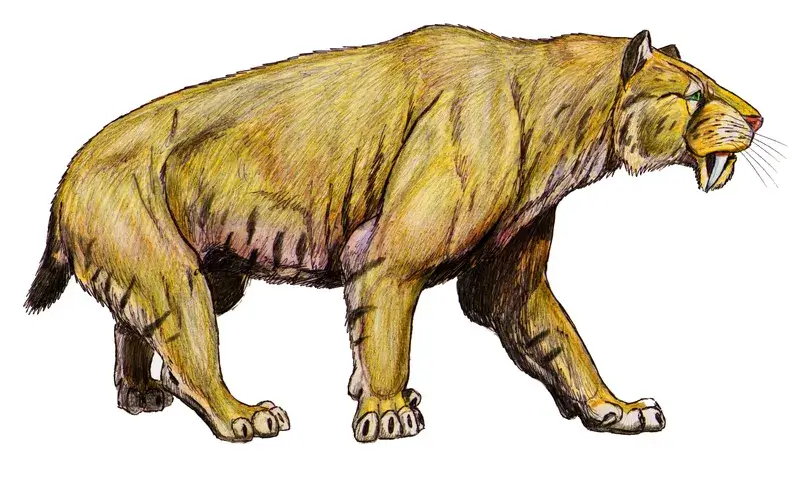
During the Cenozoic era, where the Taubaté and Solimões basins are today, there was a great diversity of fauna and flora.The Solimões basin, in particular, was a megapantanal thirty times larger than the current Pantanal Matogrossens4.
Among the animals that lived here we can mention several ungulates, ancestors of tapirs, horses, deer, camelids, rhinoceroses and mastodons.There were also the Paraphysornis brasiliensis (a nearly two-meter tall terror bird) several giant sloths and armadillos. Among the carnivores there were bears, saber-toothed tigers, marsupial hyenas, now extinct jaguars, huge snakes and crocodiles, and many other animals.27 28 29 30
The animals of the Cenozoic era are already extinct: some lineages disappeared completely, while others managed to survive and evolve into the animals we know today. We may not have any large birds of prey, but their closest relative, the seriema, lives to this day. We don’t have bears in Brazil, but we do have one species, the spectacled bear, that lives in the Andes.
Hundreds of fossil bones and footprints have been found in different places in Brazil, and many more are yet to be discovered. However, many fossils have not been preserved, and we may never fully know what animals lived here.
Read more at:
-
El País - Descoberta a Zelândia, um enorme continente submerso no Pacífico ↩︎
-
El País - Achados restos de um continente perdido sob o oceano Índico ↩︎
-
Carneiro, Celso & Mizusaki, Ana & Almeida, Fernando. (2015). A determinação da idade das rochas. Terrae Didatica. 10.20396/td.v1i1.8637442 ↩︎
-
ANELLI, Luiz Eduardo. Dinossauros e outros monstros: uma viagem à pré-história do Brasil . São Paulo: Peirópolis; Edusp, 2015. ISBN: 8575964216. ↩︎
-
Spiekman SNF, Fraser NC, Scheyer TM. 2021. A new phylogenetic hypothesis of Tanystropheidae (Diapsida, Archosauromorpha) and other “protorosaurs”, and its implications for the early evolution of stem archosaurs. PeerJ 9:e11143 https://doi.org/10.7717/peerj.11143 ↩︎
-
UC Museum of Paleontology - Introduction to the Synapsida ↩︎
-
Descrição osteológica de um exemplar de Endothiodon (synapsida, Dicynodontia) proveniente da Serra do Cadeado (formação Rio do Rasto, Permiano Superior) e suas implicações bioestratigráficas e paleobiogeográficas ↩︎
-
Martill, David & Tischlinger, Helmut & Longrich, Nicholas. (2015). A four-legged snake from the Early Cretaceous of Gondwana. Science. 349. 416-9. 10.1126/science.aaa9208 . ↩︎
-
Carvalho, I. de S., Novas, F. E., Agnolín, F. L., Isasi, M. P., Freitas, F. I., & Andrade, J. A.. (2015). A new genus and species of enantiornithine bird from the Early Cretaceous of Brazil. Brazilian Journal of Geology, 45(Braz. J. Geol., 2015 45(2)). https://doi.org/10.1590/23174889201500020001 ↩︎
-
A ‘caçada’ a ovos de pterossauro em cidade do interior do Paraná ↩︎
-
Nova espécie de dinossauro é descoberta em Cruzeiro do Oeste ↩︎
-
Kellner, A. W., Azevedo, S. A. K., Machado, E. B., Carvalho, L. B. de ., & Henriques, D. D. R.. (2011). A new dinosaur (Theropoda, Spinosauridae) from the Cretaceous (Cenomanian) Alcântara Formation, Cajual Island, Brazil. Anais Da Academia Brasileira De Ciências, 83(An. Acad. Bras. Ciênc., 2011 83(1)). https://doi.org/10.1590/S0001-37652011000100006 ↩︎
-
Vidence of Abelisauridae (carnosauria: Saurischia) from the late Cretaceous of the Paraná Basin* ↩︎
-
D.A.CAMPOS, A.W.A.KELLNER, R.J.BERTINI & R.M.SANTUCCI On a Titanosaurid (Dinosauria, Sauropoda) Vertebral Column from the Bauru Group, Late Cretaceous Of Brazil ↩︎
